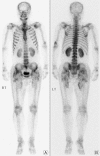Lumbosacral plexopathy, complicating rhabdomyolysis in a 57-year-old man, presented with sudden weakness in both legs
- PMID: 19096594
- PMCID: PMC2588181
- DOI: 10.3340/jkns.2007.42.6.481
Lumbosacral plexopathy, complicating rhabdomyolysis in a 57-year-old man, presented with sudden weakness in both legs
Abstract
A 57-year-old man presented with weakness in both legs upon awakening after drinking. Magnetic resonance imaging (MRI) of the lumbar spine did not reveal any intraspinal abnormalities but MRI of the pelvis revealed lesions with abnormal intensities with heterogeneous contrast enhancement in both gluteal muscles. Serum creatine phosphokinase was markedly elevated. A diagnosis of lumbosacral plexopathy, complicating rhabdomyolysis was made. With supportive care he recovered well but mild weakness of the right ankle remained at 6 month-follow-up. Pelvic MRI is a helpful diagnostic tool in localizing rhabdomyolysis. Lumbosacral plexopathy should be included in the differential diagnosis of the such cases, presenting with sudden weakness of legs.
Keywords: Leg weakness; Lumbosacral plexopathy; Magentic resonance imaging; Rhabdomyolysis.
Figures


Similar articles
-
Cocaine-Induced Rhabdomyolysis Causing Lumbosacral Plexopathy in an Adult Male.Cureus. 2022 Nov 17;14(11):e31613. doi: 10.7759/cureus.31613. eCollection 2022 Nov. Cureus. 2022. PMID: 36540520 Free PMC article.
-
Focal rhabdomyolysis and brachial plexopathy: an association with heroin and chronic ethanol use.Mil Med. 1999 Mar;164(3):228-9. Mil Med. 1999. PMID: 10091499
-
Hyperglycemia, lumbar plexopathy and hypokalemic rhabdomyolysis complicating Conn's syndrome.Can J Neurol Sci. 1997 Feb;24(1):67-9. doi: 10.1017/s0317167100021132. Can J Neurol Sci. 1997. PMID: 9043752
-
Recurrent idiopathic lumbosacral plexopathy.Muscle Nerve. 2000 Sep;23(9):1439-42. doi: 10.1002/1097-4598(200009)23:9<1439::aid-mus18>3.0.co;2-b. Muscle Nerve. 2000. PMID: 10951450 Review.
-
Differentiating Lumbar Spinal Etiology from Peripheral Plexopathies.Biomedicines. 2023 Mar 2;11(3):756. doi: 10.3390/biomedicines11030756. Biomedicines. 2023. PMID: 36979737 Free PMC article. Review.
Cited by
-
Lumbar plexopathy after radical nephrectomy -A case report-.Korean J Anesthesiol. 2012 Feb;62(2):188-91. doi: 10.4097/kjae.2012.62.2.188. Epub 2012 Feb 20. Korean J Anesthesiol. 2012. PMID: 22379578 Free PMC article.
-
Bilateral pan-plexus lesion after substance use: A case report.Turk J Phys Med Rehabil. 2019 Nov 22;65(4):411-414. doi: 10.5606/tftrd.2019.3157. eCollection 2019 Jun. Turk J Phys Med Rehabil. 2019. PMID: 31893280 Free PMC article.
-
Acute multiple focal neuropathies and delayed postanoxic encephalopathy after alcohol intoxication.Neuropsychiatr Dis Treat. 2015 Jul 17;11:1781-4. doi: 10.2147/NDT.S87731. eCollection 2015. Neuropsychiatr Dis Treat. 2015. PMID: 26229472 Free PMC article.
-
Fatal rhabdomyolysis in a patient with head injury.J Korean Neurosurg Soc. 2013 May;53(5):303-4. doi: 10.3340/jkns.2013.53.5.303. Epub 2013 May 31. J Korean Neurosurg Soc. 2013. PMID: 23908706 Free PMC article.
-
Fatal Rhabdomyolysis following Spine Surgery in a Morbidly Obese Patient: A Case Report.Korean J Spine. 2014 Dec;11(4):238-40. doi: 10.14245/kjs.2014.11.4.238. Epub 2014 Dec 31. Korean J Spine. 2014. PMID: 25620985 Free PMC article.
References
-
- Jack ER, Sydney SS, Jeffery PH. Focal rhabdomyolysis and brachial plexopathy : an association with heroin and chronic ethanol use. Mil Med. 1999;164:228–229. - PubMed
-
- Jason DW, Peter CB, Philip DT. Rhabdomyolysis : a review. Muscle Nerve. 2002;25:332–347. - PubMed
-
- Judith ET. McGraw-Hill. ed 4. 2004. Emergency Medicine : A comprehensive study guide; pp. 1749–1751.
-
- Kim EN, Sohn HS, Kim SH, Jung YA, Yoo IR, Chung SK. Tc-99 m MDP imaging in rhabdomyloysis after military disciplinary punishment. Clin Nucl Med. 2002;27:795–796. - PubMed
-
- Klockgether T, Weller M, Haarmeier T, Kaskas B, Maier G, Dichgans J. Gluteal compartment syndrome due to rhabdomyolysis after heroin abuse. Neurology. 1997;48:275–276. - PubMed
Publication types
LinkOut - more resources
Full Text Sources

